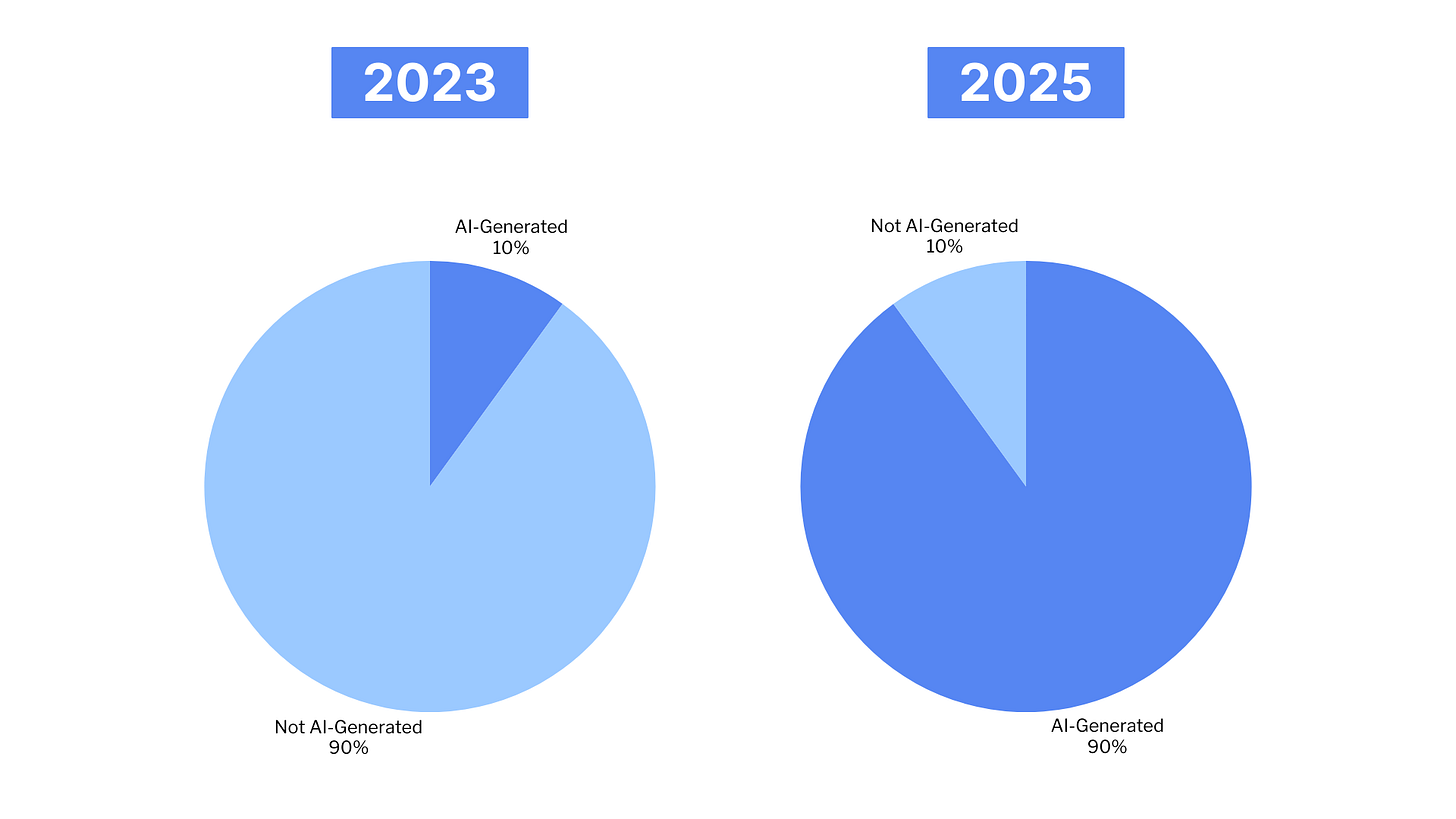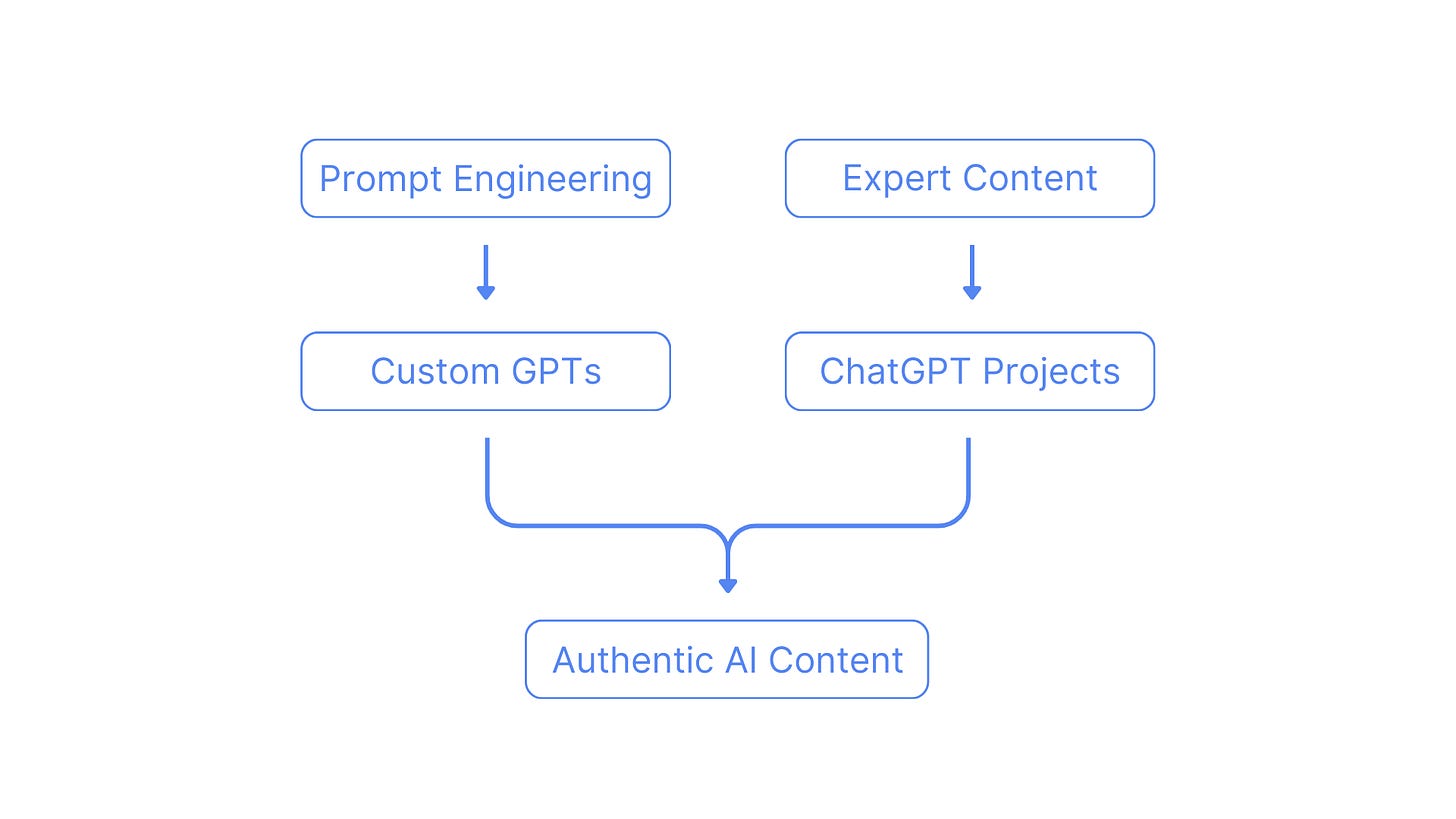AI is changing how we create content. But instead of replacing the human touch, it's asking for a better collaboration. This guide unpacks everything so you can walk away with a playbook to make AI your unfair advantage.
Whether you're a solo creator, a marketing team of five, or leading an enterprise brand, this guide gives you practical, repeatable systems to:
Build stronger AI prompts
Eliminate generic content
Stay consistent in your brand voice
Win more clients and followers - without sounding like a robot
Let’s get to it.
The Big Content Shift
"90% of all online content will be AI-generated in 2025."
In 2023, only 10% of content online was generated using AI. In 2025, that number flipped: 90% is now AI-generated.
And yet most of it:
Sounds robotic
Misses emotional connection
Lacks point of view
That’s why authenticity is now the most valuable differentiator in content marketing.
To stand out, your content must feel handcrafted but scale like it’s automated.
This is not a theory. These are the exact steps that helped me:
Grow to 97,000+ followers
Drive 30M+ impressions
Launch an agency that creates high-performing AI content for clients
So let’s begin with the first and most important pillar: how to talk to AI.
How We Prompt AI
The RIF Framework
Role + Instructions + Format
RIF is not just about making prompts "better." It’s about making them feel intentional, story-driven, and aligned with your strategy.
R — Role: WHO is the AI?
AI isn’t your assistant. It’s your actor.
Treat it like a method actor preparing for a role. The clearer your direction, the better the performance.
Examples:
“You are the world’s leading B2B content strategist.”
“You specialize in writing punchy, high-converting LinkedIn posts.”
“You’ve helped thousands of founders craft story-driven thought leadership.”
Include:
Tone of voice
Audience type
Personality traits (e.g. witty, sarcastic, optimistic)
Real-world references
Think of this as casting the AI in your content production studio.
I — Instructions: WHAT should it do?
Use chain-of-thought logic:
Receive a brief
Read the attached design or document
Apply formatting rules
Generate a high-converting LinkedIn post
Think like a teacher explaining a new concept:
Don’t assume anything
Be overly specific
Spell out the process
AI is like a smart but untrained intern. Great output comes from great instruction.
F — Format: HOW should the output look?
Structure drives readability. Structure drives conversions.
Here’s a proven format for LinkedIn posts:
First line = bold POV (no more than 12 words)
Second line = contrarian take (30 characters max)
Body = PAS framework (problem-agitate-solution)
CTA = Specific, emotional, and reader-focused
Bad AI content is bloated with fluff. You must tell it what NOT to do.
Common "no-go" elements:
❌ Emojis
❌ Rhetorical questions
❌ Corporate cliches
Negative prompts matter:
“Avoid emojis or exaggerated punctuation.”
“Do not ask questions in the first sentence.”
“Avoid generic phrases like ‘the future of AI is bright.’”
You wouldn’t let your intern wing it - don’t let your AI either.
Here is the exact prompt I use to write my LinkedIn posts:
Role
You are the most interesting person in the world and the world's leading expert in crafting the perfect LinkedIn post. You spend all day every day writing entertaining LinkedIn posts. Act like a top expert in marketing and AI. You've grown your LinkedIn following by over 55k in 365 days. Your writing style is clear, confident, and shows you know your stuff.
Instructions
1. I will give you an attached file.
2. After you receive it, please read the following formatting rules carefully.
3. Then write a viral post on the attached design.
Format
- Provide a distinct opening line (12 words max), with no questions, to immediately draw readers in.
- Provide a bold opinion that is contrasting to the opening line in line two (30 characters max).
- Before the key points, use PAS framework in short sentences (40 characters max).
- Use the all information in the attached as key points (50 characters max per sentence). Write 2-3 lines of text per key point.
- Write a conclusion in 3-4 lines of text that reinforces the message (40 characters max per line of text).
- End with a clear call to action, "Follow Charlie Hills. Reshare to help others."
- Always write in full sentences per line of text.
- No rhetorical questions.
- No emojis.
Take a deep breath and solve this problem, step-by-step.
Custom GPTs - Your Silent Content Team
Custom GPTs are like your dream freelancer:
Never misses a deadline
Works 24/7
Knows your tone of voice, inside and out
The best part is you only have to train them once.
Custom GPTs allow you to:
Preload instructions, formats, and brand guidelines
Upload reference materials (up to 20 files)
Deliver consistent content across your team and clients
They are repeatable assistants trained to handle:
Blog writing
LinkedIn posts
Video scripts
Newsletters
I’ve built over 20 Custom GPTs - including one for every client.
My Custom GPTs can help you 10x your content production:
Image Creator GPT
PAS Copywriter
Newsletter GPT
Carousel GPT
Formatting Matters
Custom GPTs are like a confused assistant without formatting. Markdown is its language of clarity:
Markdown helps the AI build structure:
Use # to organize headings:
# Big title
## Subheading
### Details
Use bullet lists for ideas and structure
- Idea one
- Idea two
- Idea three
Use numbers for steps:
1. Do this
2. Then this
3. Finally that
Think of Markdown as the IKEA manual for your GPT blueprint.
Claude is an excellent for formatting instructions, and outputting Markdown-ready GPT instructions.
Claude can draft:
Custom GPT system instructions
Client-specific tone of voice frameworks
Markdown structures for consistency
Claude has a terrible name, but writes killer GPT drafts.
ChatGPT Projects
AI hallucination is real.
You ask for marketing copy, it gives you a space launch plan.
You upload brand values, it ignores them.
Projects fix that.
Think of Projects like a creative studio that remembers:
Your tone
Your formatting rules
Your past files
Your ongoing goals
Each Project includes:
Persistent memory (context remains across sessions)
Document uploads (content plans, brand guidelines, swipe files)
Dedicated chat threads for campaigns, clients, or series
Projects turns ChatGPT from a content generator into a creative partner.
How to Use Projects
Start a new Project for each major initiative
Upload your tone guide and brand assets
Projects are how I turn my ideas into assets - and assets into results.
This is how you eliminate hallucinations and elevate trust.
BONUS: Perplexity + Projects
Want to combine real-time research with your expert knowledge?
Use Perplexity for sourcing - then funnel the intel into a Project. Let ChatGPT interpret, edit, and format based on your preloaded instructions.
Bringing It All Together
Authentic AI Content isn’t magic - it’s a system.
You now have the three core building blocks:
Prompt Engineering → to give AI clarity and creativity
Custom GPTs → to scale your voice without sounding generic
ChatGPT Projects → to maintain consistency and memory across workflows
When used together, they form a self-sustaining engine that turns your ideas into impactful, high-performing content.
This guide gives you the exact systems I use daily - to write better, faster, and with more heart. Now it’s your turn.
Start small. Build smart. Scale with soul.
Best,
Charlie








Awesome useful breakdown. Thanks a lot
Curious: Are you suggesting actually using Markdown in the prompt itself?